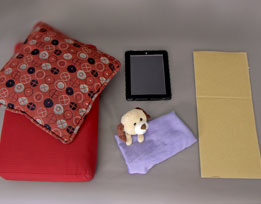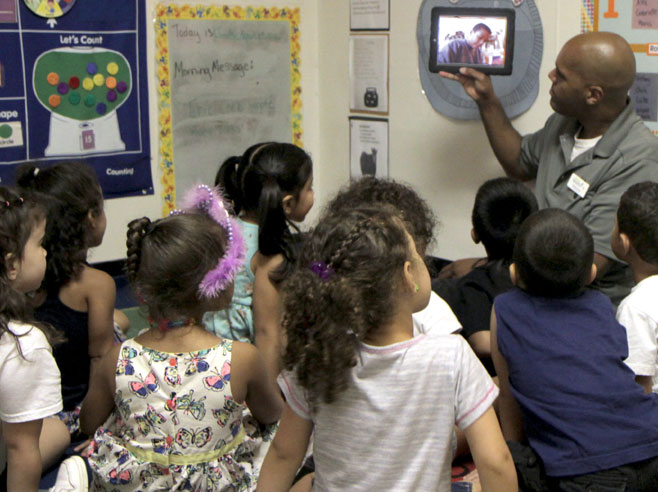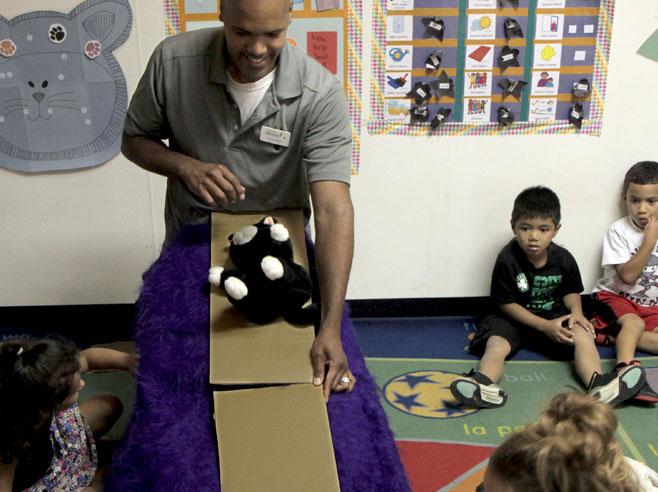In this video, children build a hill out of a sofa cushion. They try to slide a smooth plastic surfboard and a fuzzy toy bird down their homemade hill. After watching the video, children try a similar experiment in their own classroom.
Materials

- Homemade Hill video on an iPad
- Bumpy and smooth objects, such as toy animals, empty juice boxes (2 of each texture)
- Blanket or large towel
- Cushion or floor pillow
- Long sheet of cardboard
- Small plush toy
- Projector (if available)
Directions: Lesson 10
Circle Time: Introduction
Tell children that they will be watching a video, Homemade Hill, about some children who build a hill out of a sofa cushion. In the video, the children have toys that are different textures. One is smooth and one is rough.
- Explain that as children watch the video, they should raise both hands when they see the toy that is smooth. When they see the toy that is rough, they should rub their legs. Practice the motions and then watch the video.
- Pause the video after the toy surfboard slides down the cushion, and confirm that the surfboard is smooth. Have children describe how the surfboard moved: How did the smooth surfboard move on the cushion hill?
- Remind children that they will rub their legs when they see a rough toy. Then restart the video.
- Pause the video after the boy rubs the bird against the cushion to hear the sound. Possible discussion ideas:
- How did the bird move on the cushion hill?
- How was that different from the way the surfboard moved?
- Do you think there was less friction between the bird and the cushion or between the surfboard and the cushion? Why do you think so? (There was less friction between the smooth surfboard and the cushion.)
- Watch the remainder of the video. Possible discussion ideas:
- What happened when the children put the bird on the cardboard surface?
- Was there less friction between the bird and the cushion or the bird and the cardboard? (There was less friction between the bird and the cardboard.)
- Tell children that you will build a Blanket Hill in the classroom. Prop a large floor pillow or cushion against a chair or wall. Cover the slope with a blanket (or large towel).
- Pass around a plush toy for children to touch. Can you describe the texture of the toy? How does it feel when you touch it?
- Put the toy on Blanket Hill. Make sure the slant of the hill is steep enough so that the toy slides down it, at least a little. Possible discussion ideas:
- What does the toy feel like? What texture is it?
- How does the animal move when we put it on Blanket Hill?
- Does it go fast or slow? Why do you think it goes slow?
- Encourage children to build on each other’s ideas, as well as offer alternate ideas.
- Place the cardboard panel on Blanket Hill. How do you predict our toy with a rough surface will move when we put it on this smooth cardboard surface? Why do you think that?
- Put the toy on the cardboard panel and let it slide down. How did the toy move when it slid down the cardboard hill? Did it go faster or slower than before?
- Let the toy slide down Blanket Hill again so children can compare how the toy moves on different surfaces (fast or slow). Why do you think the toy slid down the cardboard hill faster than it slid down the blanket hill?
Circle Time: Wrap-Up
Children rewatch the video Homemade Hill and reflect on the question: What do we know about texture, friction, and the way things move?
- Tell children that you will show the video Homemade Hill again. As they watch, children should think about the different textures of the toys and notice how the different toys move on the two different hill surfaces.
- After the video, discuss what children observed. Possible discussion ideas:
- What did you notice about how the toy surfboard and toy bird moved?
- Which surface made the toys move more slowly: the blanket or the cardboard?
- Which surface made the toys move faster: the blanket or the cardboard?
- Remind children that when the boy rubbed the bird against the cushion, he could feel the friction and he could hear a sound. Have children work with a partner:
- Try rubbing two fuzzy or bumpy-textured things together.
- Can you feel the friction? Can you hear the sound?
- Now try rubbing two smooth things together. How does it feel? How does it sound? Is it different from rubbing the two fuzzy things together? How?
- Do you think there was more friction between the toy bird and the fuzzy blanket, or the toy bird and the smooth cardboard?


